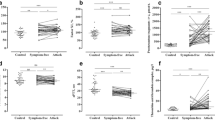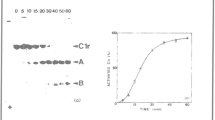Summary
Forty-five relatives of 4 families with hereditary angioneurotic edema (HANE) were studied. Twenty-five, including 11 asymptomatic kindreds with the disposition, showed typical changes in complement system compatible with HANE. Follow-up study of HANE patients showed that, even in remission period, complement, coagulation and fibrinolytic systems can be activated. During edema attacks, moderate haemoconcentration and neutrophilia were encountered and kallikrein-kinin system was found to be also activated. Replacement therapy with C \(\bar l\)-inhibitor preparation for an edema attack revealed that clinical improvement paralleled the increase in blood levels of high molecular weight kininogen. Thus, HANE attack is considered to be elicited in kindreds with the hereditary disposition by activation of plasma protease systems, particularly by that of kallikrein-kinin system. On the other hand, exogenous triggers that can initiate activation of the protease systems can be classified into 2, neuro-humoral (sympathetic nerve response) and physico-chemical, categories. Hence, the edema attack of kindreds with the hereditary disposition can at least be modified by the biosynthesis of plasma factors and the individual susceptibility to the liberated catecholamines. These two different reaction processes are considered to be linked by the release of plasminogen activator and/or Hageman factor activating enzyme.
Similar content being viewed by others
References
Aoki N, Moroi M, Matsuda M, Tachiya K (1977) The behavior of α-2-plasmin inhibitor in fibrinolytic state. J Clin Invest 60: 361–369
Blohme G, Ysander L, Korsan-Bengsten L, Laurell AB (1972) Hereditary angioneurotic oedema in three families. Acta Med Scan 191: 209–219
Borsos T, Rapp HJ, Mayer MM (1961) Studies on the second component of complement I: The single site mechanism of immune hemolysis and determination of C'2 on a molecular basis. J Immunol 71: 208–210
Borsos T, Rapp HJ (1963) Chromatographic separation of the first component of complement and its assay on a molecular basis. J Immunol 91: 851–858
Brackertz D (1974) A one year's follow up of treatment of hereditary angioneurotic edema (HAE) with suramin. Allergol Immunopathol (Madr) 11: 163–168
Cash JD (1978) Control mechanism of activator release. In: Davidson JF, Rowan RM, Samama MM, Desnoyers PC (eds) Progress in chemical fibrinolysis and thrombolysis Vol III. Raven Press, New York, pp 65–75
Castelan DJ, Hirsh J, Martin M (1968) Latex bound antifibrinogen test for plasma fibrinogen assay. J Clin Pathol 21: 638–642
Collen D (1980) On the regulation and control of fibrinolysis. Thromb Haemost 43: 77–89
Curd JG, Prograis LJ, Cochrane CG (1980) Detection of active kallikrein in induced blister fluid of hereditary angioedema patients. J Exp Med 152: 742–747
Donaldson VH, Evans RR (1963) A biochemical abnormality in hereditary angioneurotic edema. Am J Med 35: 37–44
Forbes CD, Pensky J, Ratnoff OD (1970) Inhibition of activated Hageman factor and activated plasma thromboplastin antecedent by purified serum C'1 inhibitor. J Lab Clin Med 76: 809–815
Frank MM, Gelfand JA, Atkinson JP (1976) Hereditary angioedema: The clinical syndrome and its management. Ann Int Med 84: 580–593
Gelfand JA, Sherins RJ, Alling DW, Frank MM (1976) Treatment of hereditary angioneurotic edema with Danazol. New Engl J Med 295: 1444–1448
Ghebrehiwet B, Silverberg M, Kaplan AP (1981) Activation of the classical pathway of complement by Hageman factor fragment. J Exp Med 153: 665–676
Gigli I, Ruddy S, Austen KF (1968) The stoichiometric measurement of the serum inhibitor of the first component of complement by inhibition of immune hemolysis. J Immunol 100: 1154–1164
Igarashi N, Matsumoto M, Takeuchi S, Asada T (1973) Assay method for fibrinolytic activity using affinity chromatography. J Med Technol 17: 713–722 (in Japanese)
Inai S, Nagaki K, Ebisu S, Kato K, Kotani S, Misaki A (1976) Activation of the alternative complement pathway by water-soluble glucagons of streptococcus mutans: The relation between their chemical structures and activating potencies. J Immunol 117: 1256–1260
Iwa M, Fujita S, Itoga T (1974) Studies upon the fibrinagar-plate method for measurement of fibrinolytic activity. Kyushu Ketsueki Kenkyu Dokokai Shi 24: 7–14 (in Japanese)
Juhlin L, Michaelsson G (1969) Use of a kallikrein inhibitor in the treatment of urticaria and hereditary angioneurotic edema. Acta Derm Venereol 49: 37–44
Klemperer MA, Donaldsen VH, Rosen FS (1968) Effect of C'1 esterase on vascular permeability in man: Studies in normal and complement deficient individuals and in patient with hereditary angioneurotic edema. J Clin Invest 47: 604–611
Kopin IJ, Lake CR, Ziegler M (1978) Plasma level of norepinephrine. Ann Int Med 88: 671–680
Landerman NS, Webster ME, Becker EL, Ratcliffe HE (1962) Hereditary angioneurotic edema II: Deficiency of inhibitor for serum globulin permeability factor and/or plasma kallikrein. J Allergy 33: 330–341
Loskutoff DJ, Edgington TS (1977) Synthesis of a fibrinolytic activator and inhibitor by endothelial cells. Proc Natl Acad Sci USA 74: 3903–3907
Lundh B, Laurell AB, Wetterqvist H, White T, Granerus G (1968) A case of hereditary angioeurotic edema, successfully treated with ɛ-aminocaproic acid. Clin Exp Immunol 3: 733–745
Mayer MM (1961) Complement and complement fixation. In: Charles C (ed) Experimental immunochemistry. Thomas Publishers, Springfield, pp 149–153
Nagaki K, Iida K, Inai S (1974) A new method for the preparation of EC 14 cell with human or guinea-pig serum. J Immunol Meth 5: 307–317
Ogston D, Bennett B (1978) Surface mediated reactions in the formation of thrombin, plasmin and kallikrein. Br Med Bull 34: 107–112
Oh-ishi S, Katori M (1979) Fluorometric assay for plasma prekallikrein using peptidyl-methyl-coumarinyl-amide as substrate. Thromb Res 14: 551–559
Oh-ishi S, Uchida A, Ueno A, Katori M (1979) Bromelein, a thioprotease from pineapple stem, depletes high molecular weight kininogen by activation of Hageman factor (Factor XII). Thromb Res 14: 665–672
Proctor RR, Rapaport SI (1961) The partial thromboplastin time with kaolin. Am J Clin Pathol 36: 212–219
Quick AM, Brown MS, Bancroft FW (1935) A study of the coagulation defect in hemophilia and in jaundice. AM J Med Sci 190: 501–511
Ratnoff OD, Pensky J, Ogston D, Naff GB (1969) The inhibition of plasmin, plasma kallikrein, plasma permeability factor and C 1 r subcomponent of the first component of complement by serum C'1 esterase inhibitor. J Exp Med 129: 315–331
Rosen FS, Alper CA, Pensky J, Klemperer MR, Donaldsen VH (1971) Genetically determined heterogeneity of the C 1-esterase inhibitor in patients with hereditary angioneurotic edema. J Clin Invest 50: 2143–2149
Schapira M, Silver LD, Scott CF, Schaier AH, Prograis LJ, Curd JG, Colman RW (1983) Prekallikrein activation and high molecular weight kininogen consumption in hereditary angioedema. New Engl J Med 308: 1050–1053
Schreiber AD, Kaplan AP, Austen KF (1973) Inhibition by C 1-INH of Hageman factor fragment activation of coagulation, fibrinolysis and kinin generation. J Clin Invest 52: 1402–1409
Schultz KH (1974) Hereditäres Quincke-Ödem, neuere Wege der Therapie. Der Hautarzt 25: 12–16
Uchida Y, Katori M (1978) An improved method for determination of the total kininogen in rabbit and human plasma. Biochem Pharmacol 27: 1463–1469
Uchida Y, Katori M (1979) Differential assay method for high molecular weight and low molecular weight kininogen. Thromb Res 14: 127–134
Wiggins RC, Loskutoff DJ, Cochrane C, Griffin JH (1980) Activation of rabbit Hageman factor by homogenate of cultured rabbit endothelial cells. J Clin Invest 65: 197–206
Witzke G, Bork K, Benes P, Böckers M (1983) Hereditary angioneurotic edema and blood coagulation: Interaction between C 1-esterase-inhibitor and the activation factors of the proteolytic enzyme system. Klin Wochenschr 61: 1131–1135
Author information
Authors and Affiliations
Additional information
Dedicated to Prof. emer. Dr. med. Tsuneo Yoshida on his 83rd birthday and to the late Prof. emer. Dr. med. Ernst Wollheim on his 80th birthday
Rights and permissions
About this article
Cite this article
Kodama, J., Uchida, K., Yoshimura, S. et al. Studies of four Japanese families with hereditary angioneurotic edema: Simultaneous activation of plasma protease systems and exogenous triggering stimuli. Blut 49, 405–418 (1984). https://doi.org/10.1007/BF00319889
Received:
Accepted:
Issue Date:
DOI: https://doi.org/10.1007/BF00319889




